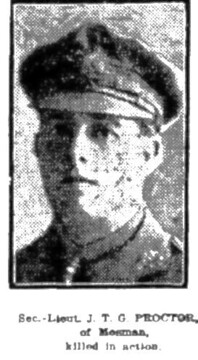
PROCTOR, James Thomas Gordon
| Service Number: | 2956 |
|---|---|
| Enlisted: | 13 April 1915 |
| Last Rank: | Second Lieutenant |
| Last Unit: | 15th Infantry Battalion |
| Born: | Petersham, New South Wales, Australia, 17 February 1893 |
| Home Town: | Mosman, Municipality of Mosman, New South Wales |
| Schooling: | Tamworth College, New South Wales, Australia |
| Occupation: | Clerk |
| Died: | Killed In Action, France, 11 April 1917, aged 24 years |
| Cemetery: |
No known grave - "Known Unto God" Villers-Bretonneux Memorial, Somme, France |
| Memorials: | Haymarket NSW Government Railway and Tramway Honour Board, Mosman Rowing Club Great War Roll of Honour, Villers-Bretonneux Memorial |
World War 1 Service
| 13 Apr 1915: | Enlisted AIF WW1, Private | |
|---|---|---|
| 31 May 1915: | Involvement Private, 2956, 5th Field Ambulance, --- :embarkation_roll: roll_number: '22' embarkation_place: Sydney embarkation_ship: HMAT Ajana embarkation_ship_number: A31 public_note: '' | |
| 31 May 1915: | Embarked Private, 2956, 5th Field Ambulance, HMAT Ajana, Sydney | |
| 11 Feb 1916: | Promoted AIF WW1, Corporal, Promoted at 4th Divisional Headquarters at Serapeum in Egypt. | |
| 24 Mar 1916: | Promoted AIF WW1, Staff Sergeant, 4th Division Headquarters | |
| 25 Jan 1917: | Promoted AIF WW1, Second Lieutenant, Infantry Training Battalions, Promoted at Officers' Training School in England. | |
| 11 Apr 1917: | Involvement Second Lieutenant, 15th Infantry Battalion, --- :awm_ww1_roll_of_honour_import: awm_service_number: awm_unit: 15th Australian Infantry Battalion awm_rank: Second Lieutenant awm_died_date: 1917-04-11 |
Help us honour James Thomas Gordon Proctor's service by contributing information, stories, and images so that they can be preserved for future generations.
Add my storyBiography contributed by John Oakes
James Thomas Gordon PROCTOR was born on 17th February 1893 at Petersham in Sydney. His parents were James Martin Proctor and Anna Barbara Clemintina Proctor. On 22nd March 1912 he joined the NSW Government Railways and Tramways as a junior clerk in the Locomotive Branch at Eveleigh. On his 21st birthday, 17th February 1914, he progressed to the grade of clerk. On 13th April 1915 he was released to join the Expeditionary Forces.
He joined the AIF on 13 April 1915 with the rank of Private (Service Number 2956) and was posted to the 5th Field Ambulance. For his next of kin he nominated his father, who at this time was living at Mosman in Sydney.
James embarked for Egypt aboard HMAT A40 ‘Ceramic’ at Sydney on 15th June 1915. On 1th August 1915 he embarked at Alexandria for Gallipoli. On 17th September 1915 he reported sick with dysentery and was evacuated to Malta, where he was admitted to hospital on 21st September 1915. He remained there until 16th January 1916 when he embarked to return to Egypt, where he was admitted to No. 3 Auxiliary Hospital at Heliopolis on 21st January 1916. He was finally discharged, fit for duty, on 27th January 1916.
On 11th February 1916, James was taken on strength of the 4th Divisional Headquarters at Serapeum (Egypt) and he was promoted to the rank of Corporal on the same day. On 24th March 1916 he was promoted to the rank of Staff Sergeant. He embarked France as a member of the 4th Divisional Headquarters, at Alexandria on 2nd June 1916 and disembarked at Marseilles on 8thJune 1916. On 3rd October 1916 he was detached to Officers Training School in England.
On 25th January 1917, James passed as qualified for commission in Infantry. He was appointed 2nd Lieutenant in the AIF and was posted to Infantry Reinforcements. He proceeded to AIF Headquarters at Oxford on 26th January 1917 and was then sent on furlough until 3rd February 1917. He marched in to the Infantry Draft Depot at Perham Downs on 4th February 1917. On 16th February 1917, he left England for France. In France, he went to Reinforcement Camp until 20th February 1917 when he proceeded to join the 15th Infantry Battalion, where he was taken on strength on 23rd February 1917.
On 11th April 1917 he was reported as being missing in action, and a subsequent Court of Enquiry determined he had been killed in action on this date.
Depositions in his Red Cross Enquiry file provide more information. Corporal R Purchase (832) stated:
‘He was my platoon officer … I saw him killed at Bullecourt on the morning of 11th April. He was caught by M.G. fire or rifle fire. Only about three of the platoon got by it. He was killed at once – we had to go and leave him there. We gained our objective but had to retire after about 8 hours and did not hold the ground where he fell. He was walking beside me when he was shot.’
Lance Corporal F.W.C.A. Peachey (940), escaped prisoner of war, stated:
‘The last time I saw him was about 15 minutes after the advance when it was still dark near the British side of the German wire. He was wounded lying on his side I think wounded about the head or face because he had blood on his face. He was quite still and may have been dead then. After I was captured a friend (I forget who it was) said he had seen Mr Proctor killed. He was my platoon commander and we went over together but the smoke was very dense. The Germans made us bury about 200 of our own dead in the afternoon without removing discs but I don’t know if Lieut. Proctor was buried or not.’
The site of his grave, if any, is unknown and he is commemorated at the Villers-Bretonneux Memorial, Villers-Bretonneux, Picardie, France. His place of association is Sydney, NSW.
After his death his mother was granted a pension of £3 per fortnight with effect from 21 June 1917.
- based on the Australian War Memorial Honour Roll and notes for the Great Sydney Central Station Honour Board.









